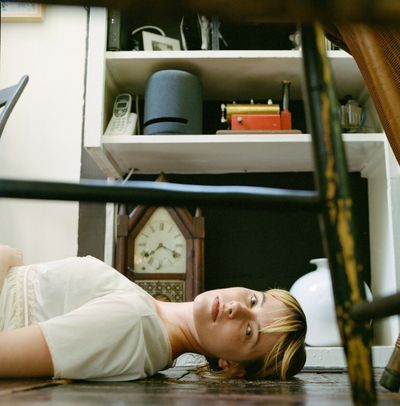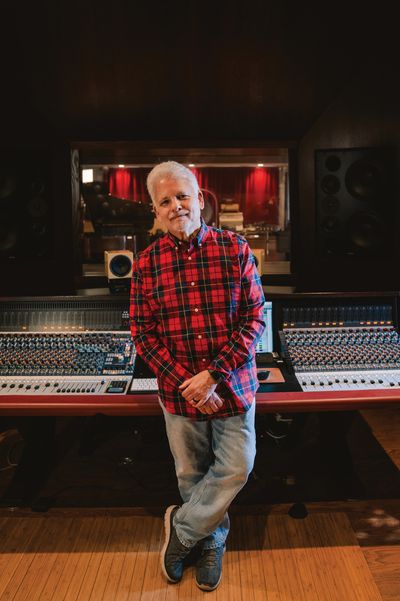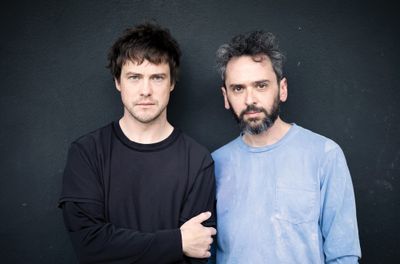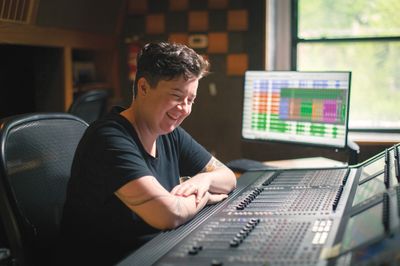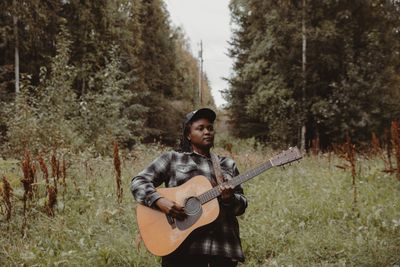What got you started in recording and production?
I guess I ended up being the guy doing it from the beginning. Back in high school, we had a Peavey mixer and would run it to a stereo cassette deck and record everything that way. Then I recorded a few friends’ bands that way as well.
As early as high school?
Yeah. Maybe even freshman year.
Wow. And was that about the time that Season to Risk started?
I graduated in ‘87, and Season to Risk started in late ‘89 or ‘90.
But you'd already been playing?
Yeah. I was in a punk band called Curious George with Duane [Trower] from Season to Risk. At first it was Curious George, and we were looking for a different singer. But then we met [Steve] Tulipana, who was in a band called Nine Lives, and we asked him to join. We changed the name because it started to be completely different music than what we were doing before. And [Season to Risk] was the title of one of the songs we wrote with Steve, so that's where that came from.
Were you the guy manning the board at that time too?
No, I wasn't, but I was definitely interested in it. But we started recording at Westend Recording Studios here in Kansas City. I ended up working there forever, all throughout the ‘90s and '00s, until I got my own spot. The engineer at the time was Bart [Ward] – great guy, RIP – and he was very liberal with letting us sit at the board and run the tape machine while he was in the back room doing other things. We got a lot of experience that way.
Were you cutting tape back then?
The only tape cutting we did was for mixdown on 1/4-inch or 1/2-inch [tape]. Rarely was it cutting together takes on 2-inch back then. But we did so later on in the game, more out of necessity rather than luxury.
That's back when you had to get the take right.
Yeah. Josh [Newton] was telling a story the other day that I'd forgotten about. It was the last day of mixing [Shiner’s] The Egg, and we were at Great Western Record Recorders, Matt Talbott’s studio in Champaign [Illinois]. That was the first record that was ever recorded there. Matt got that studio, and then I brought J. Robbins [Tape Op #13] and Jason Livermore [#156] in to do the record. It was the last day, we're all stoked – having a listening party in the control room, and halfway through the song “Simple Truth,” we heard this stretching sound and tape was shooting up in the air! It was terrifying. Luckily, we had another take of that song and cut in just that section. That was some hot-rod tape cutting on Livermore's part.
I never noticed.
I'm not even sure if I could pick it out. I may have PTSD'd it out of my brain! [laughter]
So, what year did you start Massive Sound?
I got this space in 2008. I initially had one partner, Mike Nolte. He's in Portland now and he does all my mastering. He was my first partner here, then he wanted to move on to just mastering, and he ended up moving up there with his wife. My current partner, Chad Meise, moved in in 2013, and with him came a lot of the awesome gear that's at this place.
What's the story on the console you have there now?
This is a 1973 Auditronics 501 "grandson" that came out of Stax [Records].
How did that even come about?
I think they sold it to the RLDS Church; their headquarters is in Independence, Missouri, about 20 minutes outside of here. They have an amazing production facility; they had this, plus a bunch of other gear they’d used throughout the '80s and ‘90s. A friend of mine, who runs a big sound company here, acquired this and a bunch of other gear. He got it very cheap. It's amazing.
A total piece of history. On the many recordings you've done, the rhythm section is always carved out in such a specific way and it's always massive. It goes right along with the studio name. How did you come up with that sound?
I started on drums.
There you go!
Then I went to guitar, and I ended up being a bass player. That's why I play bass more like a guitar!
That's why I wanted to work with you on the Last Giant records. I also loved the Riddle of Steel album, 1985, that you did. That record sounds massive. I'm wondering what records you listened to that influenced that sound?
The music I grew up bonding with early on was Billy Squier and Led Zeppelin – heavy-hitting, natural-sounding rock bands. The Knack's “My Sharona” was the first seven-inch I ever got. That probably says quite a bit right there! [laughter]
Yeah. I think a lot of the bands around Kansas City – Season to Risk, Shiner, Molly McGuire, and Paw, had an identifiable sound. Did you all hang out?
We mostly did hang out. We were a pretty tight scene back then. Even Paw, even though they were a Lawrence, Kansas, band. They were the band that was supposed to be huge from here, and there was a big label feeding frenzy off their demo. They ended up signing with A&M Records. Season to Risk fell into our label deal with Red Decibel that ended up being a deal with Columbia Records. But did we hang out? Absolutely. We'd have parties, we’d do shows, and we would all play together all the time. A lot of us cross-pollinated, member-wise.
Which brings us to you ending up in Shiner.
Here's the glue to a lot of it: I worked for a company called Chameleon Dental Products. It was a dental product company that supplied stuff to dentists’ laboratories to make porcelain veneers. One of my friends from high school, her family owned this company, and I started working there almost immediately. Anyway, a friend of hers, Shawn Sherrill, got a job there as well. We became buddies working there, and then along comes Allen Epley, who was also in Shiner and at the time was in a band called The Industry. We're all working at this place, putting stuff in boxes, measuring out powders and liquids, and we were listening to music all day long. We shared a lot of the same likes. Al will tell you that it took him a while to get used to showing up to work at 8 a.m. and I'd be blasting Jesus Lizard in his face. He had never been greeted that way. [laughter]
Is that about the time you were in Season to Risk and he's in Shiner?
I was in Season to Risk early on. We were kind of the first band that started to get attention. Allen was in The Industry; they stopped playing and he wanted to start a new band. Wednesday or Thursday nights we'd get together in the practice space; me, Al, and Shawn. Shawn didn't know how to play anything, and we taught him to play bass. We had a big ensemble noise rock band called Godpipe. We would drink Wild Turkey. Al played drums, I played guitar, Shawn played bass, Tulipana sang, and we had other people from time to time. I don't know if we ever did a show, but it was more like a night to get together and party. Shawn learned to play bass in Godpipe, to a certain degree. When Al started Shiner, he was like, “I'm thinking about asking Bass Face if he wants to play bass.” [laughter] Because we used to call Shawn Bass Face! Al brought him in and melded him into a great bass player and they recorded Splay shortly after that.
Which you recently remixed.
That record was recorded in ‘94 by Bob Weston in Steve Albini's basement.
Were you guys already listening and paying attention to the Chicago bands?
Oh, hugely influenced by all of them.
Was that a big deal for Shiner to go record there?
Absolutely. They were stoked. It was with DeSoto [Records]; I don't know what budget they had, but it wasn't a lot. They did the entire record in four days.
That's fast! Did you have to do any tape transfers for this remix?
We had the 2-inch tape, and we had to transfer it to digital. Mike Miller at Westend [Recording Studios] has gotten pretty good at it. He "bakes" it in a convection oven at 120 degrees for eight hours. I guess it glues all the chemicals back enough so that it doesn't fall apart when you run it. I know you can't run the tape a bunch of times or it'll get all goopy or start flaking off.
Did you ever think back then, “I would have mixed Splay a little different”?
Yeah, the problem that everybody had was that there wasn't much low end coming from the bass. It was mixed and recorded in four days, so I'm not sure how much detail was spent on that. They were never quite happy with it but had never thought of remixing it.
Listening to the remix, that low end is there and it sounds like a proper Shiner record.
Well, I'm sure there'll be purists that are really angry about it, and I'll have to deal with it. But now it sounds like the band that I used to love watching. I knew what they sounded like, and that the record wasn't it. But it didn't take me long to get it there. I didn't spend a tremendous amount of time doing those remixes. I made it sound like I thought it should sound, and I did a couple of delay and reverb treatments to make it open up a little bit. For the most part, it was pretty quick business. I've got some other Shiner B-side tracks that I've been messing with that we baked as well, and it's just astounding – especially low end, how much rounder it is off the 2-inch.
Did Mike Nolte do the mastering?
Yeah, he generally does all my mastering unless there are other required people involved – which is also fun, because I like to mix it up. But Nolte's my guy.
Do you have any mixing and production influences?
Dave Sardy [Tape Op #33] was my favorite engineer/producer. Shiner and Season to Risk both did a decent amount of touring with [his band] Barkmarket, so we used to talk and he would give me advice. I’ve always been a fan of his mixes and his production, so that had a huge influence on me. Steve Albini definitely had plenty of influence on me as far as bass and drum sounds from that time. Eli Janney has always made great records. Always J. Robbins and Jason Livermore. I've been lucky enough to get to work with a lot of these people that I'm talking about. I unfortunately never got to do anything with Steve, but I certainly would’ve loved to.
Speaking of Jason Livermore, didn't Shiner work at The Blasting Room [Studios] on Starless?
No, but we demoed three songs for The Egg at The Blasting Room – everything else was mixed at Westend. We tracked half of Starless in Champaign, Illinois, at Pogo Studio. That was the late Mark Rubel’s [Tape Op #47] studio, and Hum had introduced us to him. We did Starless there, and then I did a couple other projects there over the years. It was an amazing studio.
With the Starless, were you part of the production team?
I was half of it. We went to Pogo and did drums, bass, and guitars for half the songs on the record. Then all the others were recorded by me at Westend. Then I had Jason Livermore come and we worked together on the mixes here in Kansas City.
Shiner have always evolved. Starless was an album that had more pop sensibility than the first two records, yet it still has angular guitars and a huge rhythm section.
There were a lot of things going on. That was the first record with [Jason] Gerken playing drums, and it was also the first record that we were a four-piece. The first second guitar player we had was Joel Hamilton [Tape Op #41, #85]. I'm sure many people have heard his name from Tape Op! Joel was in the band, and he was there for all the basics for Starless. A few months later he ended up moving, and we ended up finishing the record with Josh Newton. Josh redid some of Joel's parts, but not all. Lots of member changes and figuring out what we were doing. It was a weird time for bands like us that always seemed to be almost successful – whatever “successful” means – always right on the cusp of making it happen. At that time, we had several label conversations and meetings, as well as a lot of let-downs.
The definition of success in the ‘90s was different than it is today.
Yeah. We wanted to be able make a living doing this. Season to Risk was certainly lucky enough because we lucked into a small amount of major label money. That enabled us to not have real jobs – or at least ones that we could walk away from. Mostly we just practiced and toured.
Were you recording actively too?
Other than some demos for different bands, the first record that I recorded that wasn't one of my bands was the Glazed Baby record, Atomic Communists. That was a collaborative effort between Duane Trower and myself – we were both in Season to Risk, we were both aspiring engineers, and we somehow talked those guys into letting us produce their record.
Was there a certain record you made where you felt, “I'm ready to open a studio. I'm ready to do this.”
I did two records for a band from L.A. called Open Hand. The first one [You and Me], we had the biggest budget that I'd had to make a record at that time. I had never made a record on Pro Tools yet. I went to The Blasting Room because Jason Livermore had been working in Pro Tools for at least a couple of years at that time. I produced the record, we made it there, and I basically went to Pro Tools school for about two months. I learned a lot making that record, on many levels. And I played bass on it as well. We mixed some of that back in Kansas City, and then some at The Blasting Room. That was a huge learning experience for me. I liked recording up at Matt Talbott's place [Earth Analog Recording Studio] in Tolono [Illinois]. Any time I wasn't on tour, I was trying to find bands to record. We'd go stay up there for five or six days, make a record, and then come back to Westend and mix it.
You have a lot of history with Westend. Do you work there anymore?
Not working. I go there to visit quite a bit. The engineer there now, Justin Mantooth, is awesome. He's always making records. I would love to go do some mixes up there sometime, but it's been a minute.
What's going on in Kansas City now? Are you seeing a resurgence of rock bands?
It's coming around. The fact that everyone can make a record in their bedroom to some level has been such a hurdle to get over. I think enough time has passed that a lot of artists realize that just because they can doesn't mean they should. A lot of valuable work can be done that way, and then you can come into a real studio and get the best sounds you can get. I also get a lot of sessions that aren't the best sounds, and it's a challenge. I don't mind messing with other people's tracks, as long as they're not peaking or something that I have to work hard to fix. As long as they're neutral, I can get someplace with them.
I think all the years of recording in studios has been helpful in setting up my own space.
That's how I learned. I didn't go to school. I didn't take any classes. I learned from experience, and from being submerged as much as I can, whenever I can. Spending stupid long days not because I had to but because I wanted to. A day for me used to vary from 10 to 15 hours. I didn't make any more money, I just pushed myself as far as I could go.
The band's new album is out now. How did that start?
Shiner has been chipping away at a new record for the past year and a half. We all live in different parts of the country – Gerken and I live here in Kansas City. Allen lives in Chicago, and Josh lives in L.A. but he spends the majority of his time touring as a guitar tech. We have to plan to get together for a handful of days at a time and camp out in the studio. The formula seems like it's four songs in four days that we'll write and record. It's a whole new adventure for Shiner.
Was Believe You Me all tracked at your studio?
It's all been done here at Massive, except Al's been doing a lot of his vocals at his place in Chicago. That's the same way we did it for the last record, Schadenfreude. We tracked it all here, Al worked on vocals there, and then he came down and retracked some of them. It was probably 50/50. Other than that, everything's been done here. Mixing started with Mario Quintero (of Spotlights) here.
Why did Shiner decide to have Mario mix the new album?
Good question. With the exception of Schadenfreude, all of our records in the past have had multiple engineers involved in the process. We wanted to get another set of ears in on the mixing process to take it to the next level. He's a dear friend and an amazing talent. We spent a week at Massive working on the mixes together. Then he took it home to Pittsburgh where he made tweaks and finalized the mixes over a couple months. I think the collaboration worked great; we're really proud of the results.
Were there equal songwriting duties?
Allen has always been the primary songwriter. He brings in ideas and we expand on them. We'll create our own parts and arrange the songs.
Were you passing demos to one another before the sessions?
Allen and Josh both had rough demo ideas for most of the record. Some were more formed than others.
Were there any gear choices or tunings that helped create the moods or colors of Believe You Me? It was mostly all the usual suspects for gear and tunings. Al used his Hiwatt amp and [Fender] Telecaster. Josh used a variety of amps and lots of different pedals. I used my Peavey Classic 400 [amp head] and Ranger 215 [cabinet] with my custom [Fender] P-Bass, mostly in my drop C tuning. I guess the big difference would be the drum kit. We used a 1970 Rogers 22-inch, 13-inch, 16-inch kit and a Ludwig Supraphonic snare. On Schadenfreude, we used Jenkins-Martin toms and snare with a C&C [Drum Company] 24-inch kick drum.
Were there any inspirations for the new album?
Honestly, I think the biggest inspiration would have to be the band itself. The evolution of our sound and sonic footprint led us to this record. ![]()
